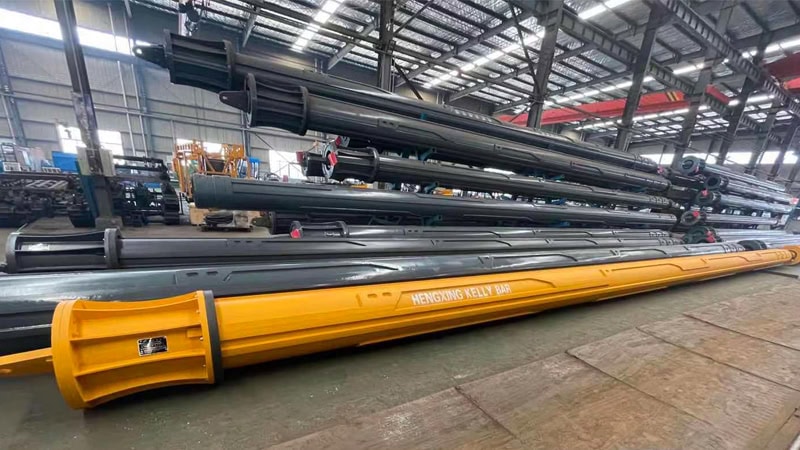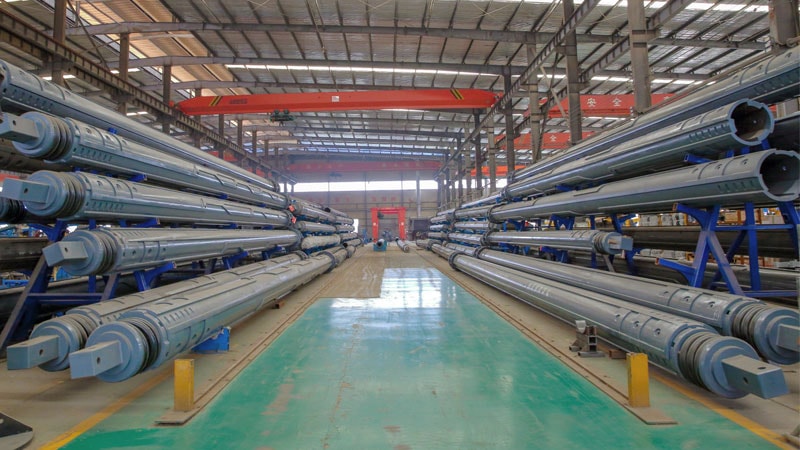
Key Takeaways:
- Proper torque prevents deterioration and guarantees the drilling tool operates safely.
- Matching bar torque maintains order and protects project efficiency.
- Different bar types suit varying diameter holes and soil conditions.
- Reviewing specs and custom solutions keeps operations secure during construction.
Torque in Kelly bar drilling refers to the rotational force transmitted through the bar during operation. Matching the correct torque to your rig ensures both reliable performance and essential operator safety on site.
Exceeding a Kelly bar’s rated torque can cause serious risks, including bar breakage, structural damage, and accelerated wear. Proper torque alignment preserves the bar’s integrity, reduces downtime, and maintains consistent drilling accuracy across projects, while minimizing the impact on equipment and schedule.
This article explores the difference between usable torque and rig torque limits, the role of safety factors, and calculation examples. Everstar provides Kelly bars with certified torque ratings tested for durability and trusted performance for your projects.
What Is a Kelly Bar Torque Rating?
A Kelly bar torque rating defines the maximum rotational force the bar can safely withstand during drilling. This value is central to project planning because it directly influences rig compatibility, drilling accuracy, and overall site safety.
Definition and Purpose
The torque rating is the maximum force a Kelly bar can handle without risking structural damage. It establishes the standard for wear performance, ensuring each telescopic section provides consistent power transfer during rotary drilling operations.
Why Torque Ratings Matter in Drilling
Proper torque matching prevents twisting, cracking, or complete failure of the Kelly bar adapter under rig loads. Precise alignment between rig torque and bar capacity protects operators, ensures borehole accuracy, and minimizes costly interruptions on demanding projects.
Usable Torque vs Rig Torque

In practical drilling operations, such as foundation piling or deep borehole projects, the rig’s advertised torque does not always equal the torque actually delivered to the Kelly bar adapter. Usable torque depends on soil resistance, deterioration, and format factors, supporting safe and efficient operation of your tool.
Maximum Rig Torque Capacity
Rotary rigs provide torque ranges as an indicator of rotational power. Don’t forget that not all of this torque safely reaches the Kelly bar — limits depend on bar design, material strength, and locking dog assembly efficiency.
Usable Torque for the Kelly Bar
The usable torque is always less than the rig’s maximum rating. Soil density, interlocking or friction bar design, and accumulated wear decrease effective force, making accurate torque calculation crucial for consistent, reliable drilling results. Torque is typically expressed in kNm and ft lb for clarity.
Risks of Exceeding Kelly Bar Torque Rating
Exceeding a Kelly bar’s torque rating can lead to structural damage, cracking, or complete bar failure. These issues pose safety risks for operators, result in costly maintenance and repairs, and cause downtime that affects project schedules.
Kelly Bar Torque Capacity by Design
Understanding torque capacity requires distinguishing between friction, interlocking, and multi-locking Kelly bars. Each design handles torque differently, which influences its suitability for specific soil conditions, drilling depth, and overall operational efficiency.
Friction Kelly Bars
The Friction Kelly bars’ torque capacity relies on mechanical components such as drive keys and provides downforce from self-gravity. These features make them ideal for soft to medium-density soils. Remember that usable torque depends on the quality of section contact and proper lubrication, which ensures consistent performance and reduces wear on the bar.
Interlocking Kelly Bars
Interlocking Kelly bars transfer high torque through the locking dog assembly, providing stability under demanding conditions. These bars are ideal for deep drilling and hard soils, where maximum torque, precise borehole alignment, and correct Kelly bar hole distance are essential.
Multi-Locking Kelly Bars
Multi-locking Kelly bars feature a balanced design with adjustable torque handling. Keep in mind that this adaptability suits mixed soil conditions, offering flexibility across varying densities while maintaining structural integrity and operational efficiency.
Installation and Torque Transfer Components
Proper installation of the dog assembly, lock washers, and painted lock washers assures reliable torque transfer. Correct use of the bent arm pin and coil lock, along with aligning the inside width and hex components, maintains consistent torque performance. The flange surface and green protective paint further improve durability.
Safety Factors in Kelly Bar Torque Ratings
Safety is critical in construction, and a proactive approach reduces the risk of Kelly bar failure while maintaining consistent drilling performance and minimizing maintenance needs. Thoughtful design, disciplined operations, and preventive measures work together to protect both equipment and crew.
Built-In Safety Margins
Manufacturers rate torque below the bar’s maximum breaking point to create a safety buffer. Typical factors range from 1.2x to 1.5x, providing confidence that the bar can endure unexpected loads without compromising structural integrity.
Operational Best Practices
Aligning rig output with the Kelly bar’s limits is essential. Monitoring torque fluctuations in variable soil layers and adjusting drilling parameters accordingly prevents unnecessary stress on the bar, maintains consistent borehole diameter, and ensures more predictable results.
Preventing Breakage and Fatigue
Overloading during repeated cycles accelerates wear and shortens bar lifespan. Operator training, careful handling, and torque monitoring systems are key to extending durability and minimizing downtime, keeping projects on schedule and protecting equipment weight balance.
Sample Torque Rating Calculations

Practical examples help illustrate how torque ratings apply in your project. Small rotary rigs and large crawler rigs operate differently, then understanding usable torque guarantees safe, efficient drilling across varying tool types.
1. Small Rotary Rig (100 kNm)
For a small rotary rig with a maximum torque of 100 kNm (73,750 ft lb), a Kelly bar rated at 90 kNm can safely handle 80–85 kNm. This range provides a margin that protects the bar while maintaining consistent borehole performance on your site.
2. Large Crawler Rig (400 kNm)
A large crawler rig with 400 kNm (295,000 ft lb) of maximum torque paired with a Kelly bar rated at 350 kNm can operate safely between 300–320 kNm. Staying within this range reduces stress on the bar and ensures reliable drilling for your project under heavy loads.
Matching Rig Torque to Kelly Bar Capacity
Understanding the context, manufacturer specifications, and available solutions is essential for safe and efficient drilling. Proper torque alignment prevents equipment damage and supports smooth progress on your project.
Reading Manufacturer Specs
Reviewing torque charts for both rigs and Kelly bar adapters helps identify compatibility issues. Operators should confirm maximum rig torque, Kelly bar hole distance, bolt circle, section lengths, and connection types to ensure safe, efficient torque transfer.
Kelly Bar Adapter and Bolt Circle Considerations
Proper selection and installation of the Kelly bar adapter and alignment with the bolt circle are critical. This ensures efficient torque transfer, reduces wear, and maintains consistent, safe borehole performance throughout your project.
Why Custom Solutions May Be Required
Some projects demand custom torque-rated bars, especially for unusual soil conditions, deep boreholes, or heavy-duty rigs. Everstar can design Kelly bars tailored to specific torque requirements, offering options such as reinforced sections, six holes, or modified lengths to guarantee reliable performance and enhanced safety for unique drilling applications.
FAQs
What does torque rating mean on a Kelly bar?
A Kelly bar’s torque rating is the maximum rotational force it can safely handle. It ensures structural integrity, prevents damage under load, and guides operators in aligning rig output to the bar for consistent, safe drilling performance.
How do I calculate usable torque for my rig?
Usable torque accounts for the rig’s maximum torque minus losses from soil resistance, bar type, and wear. Comparing rig specs with the Kelly bar rating ensures safe operation, prevents overload, and maintains consistent borehole accuracy across varying drilling conditions.
What is the max torque for a Kelly bar?
Maximum torque is the highest rotational force the Kelly bar can endure without risk of structural failure. It depends on design, material, and locking type, with safety factors applied to protect the bar during standard and challenging drilling operations.
Why can’t I use full rig torque on my Kelly bar?
Not all rig torque transfers safely to the bar due to soil resistance, bar design, and dog assembly. Exceeding the bar’s rated torque risks breakage, structural damage, and operator hazards, so usable torque is always lower than the rig’s maximum.
How do torque ratings differ between friction and interlocking bars?
The difference in torque rating is not decided by whether the bar is friction or interlocking. Torque transfer occurs mechanically through drive keys in both friction and interlocking bars, rather than through frictional contact. Therefore, interlocking bars are preferred for deep drilling requiring robust stability, whereas friction bars are simpler and suited for projects with moderate soil conditions.
Conclusion – Getting the Most from Your Kelly Bar Torque
Matching rig torque with your Kelly bar’s rated capacity is essential for safe, efficient drilling. Different bar types offer varying torque limits, and exceeding them can lead to cracking, breakage, and costly downtime.
Usable torque is always lower than the rig’s maximum, factoring in soil resistance, wear, and bar design. Everstar provides torque-rated Kelly bars you can rely on, supported by engineering expertise, rigorous quality control, and customization options to meet the demands of your projects.
Ready to Optimize Your Drilling?
Contact Everstar Machinery for expert guidance and high-performance, torque-rated Kelly bars designed to match your rig specifications. Support safe, efficient drilling operations while achieving reliable, long-lasting performance across all your foundation projects.